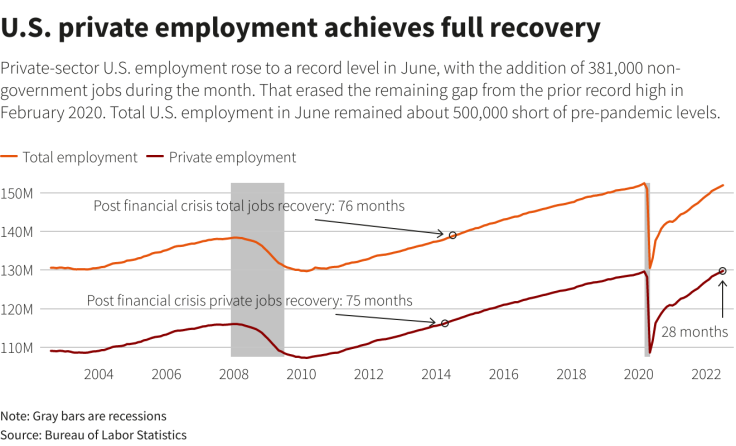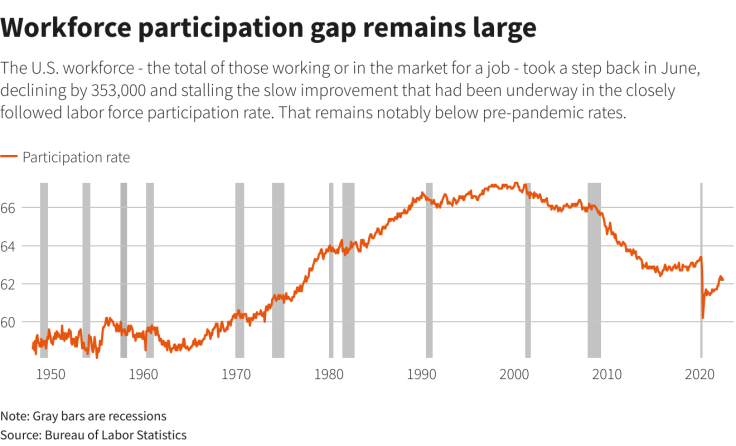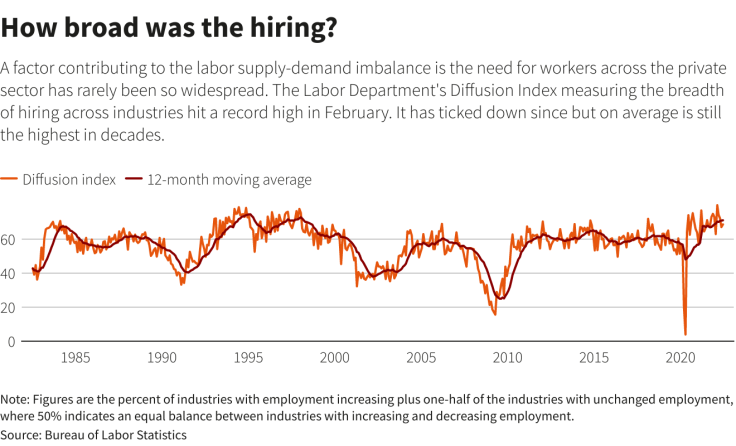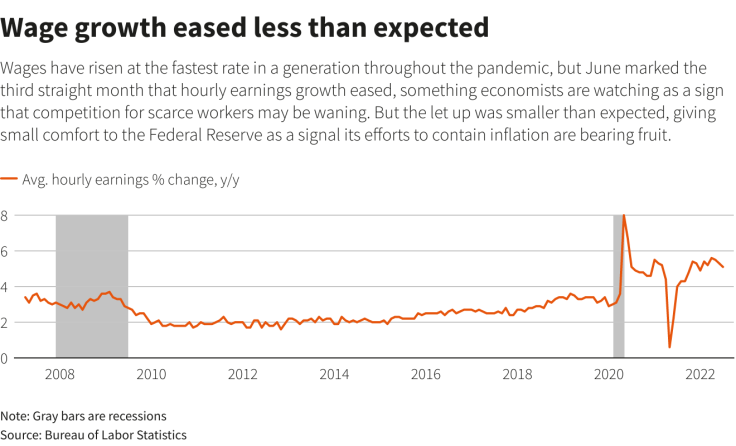Five Key Facts From The U.S. Jobs Report: No. 1 - A Return To Record Private Employment

Recession worry-warts did not find much to fan their anxiety in Friday's stronger-than-expected U.S. employment report for June, even as high inflation and the Federal Reserve's efforts to contain it through interest rate hikes keep blood pressure high on Main Street and Wall Street.
For one, the private sector - accounting for 85% of all U.S. jobs - returned last month to a record level of employment for the first time since the COVID-19 pandemic struck in early 2020. Job creation overall held steady and remains well above the pre-pandemic trend, with the jobless rate in June holding fast at 3.6%, near half-century lows.
Here are five key factors to eyeball in the report.
RECORD PRIVATE EMPLOYMENT
Total U.S. employment in June of nearly 152 million was still more than 500,000 jobs short of the February 2020 record high.
The big news, though, was in the private sector. There, the addition of 381,000 new jobs - about 140,000 more than expected - was enough to lift total private employment to nearly 130 million, erasing what had remained of the corporate employment hole carved by the pandemic.
Nonetheless, even that milestone came with caveats: Substantial gaps remained in some of the hardest-hit industries, especially leisure and hospitality, where total employment remains more than 1.3 million below the pre-pandemic high.
GRAPHIC: U.S. private employment

LAGGING PARTICIPATION RATE
A sore spot in the employment recovery has been the tepid rate of labor force participation. The overall workforce - the total of those working or looking for a job - contracted in June and remains about 600,000 bodies short of the pre-pandemic level. Moreover, because the working-age population grew throughout the health crisis, the closely tracked participation rate has been particularly slow to show improvement.
It took a step back in June to 62.2% from May's 62.3%, leaving the participation rate 1.2 percentage points below where it was before the pandemic, at roughly the level that prevailed in the late 1970s. Fed officials like Chair Jerome Powell have pined openly for a return to the rising participation trend that took hold late in the economic expansion that was upended by the pandemic.
GRAPHIC: Workforce participation gap

DEMOGRAPHIC SHIFTS
The participation rate story has some key subplots, including a recent reversal of long-standing racial trends.
Since the Bureau of Labor Statistics began tracking employment data by race in the early 1970s, the participation rate for whites has been sizably above that for Blacks. The tightness of the COVID-recovery job market, though, has provided more opportunity for traditionally disadvantaged groups and in the last year the Black rate has topped the white rate for the first time. June's report marked the third consecutive month with the Black rate - last at 62.2% - topping the white rate - 61.9% last month.
GRAPHIC: Racial participation gap

HIRING BREADTH
The demand for workers has rarely been as widespread across private industry groups as it has been in the last year, a factor contributing to the worker supply-demand imbalance.
The BLS tracks that breadth through its Diffusion Index. It hit a record high earlier this year and over the 12 months through May its average level was the highest in a quarter century. The monthly reading ticked up in June after three consecutive declines, offering little indication yet that the period of hottest demand for workers has passed.
GRAPHIC: How broad was the hiring?

SLOWING WAGE GAINS
Workers during the COVID era have been seeing the largest wage gains in a generation or more, but there are indications that wave may have crested.
June's year-over-year increase in average hourly earnings was a higher-than-expected 5.1% and the prior month was revised up to 5.3%. While the June figure was a third straight decline and the lowest in half a year, the slow pace of easing wage gains offers little respite to Fed officials who worry the outsized increases are helping to keep inflation running at its highest rate in 40 years.
GRAPHIC: Wage growth

© Copyright Thomson Reuters 2024. All rights reserved.




















